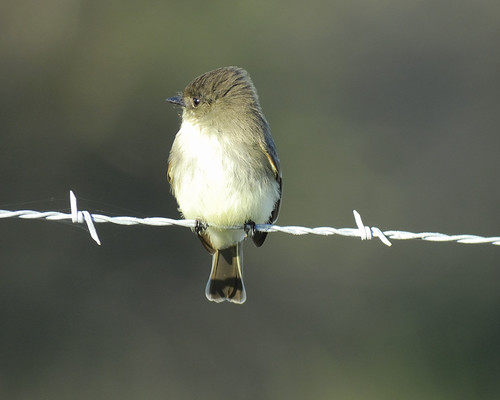tags: Eastern Phoebe, Sayornis phoebe, birds, mystery bird, bird ID quiz
[Mystery bird] Eastern Phoebe, Sayornis phoebe photographed at Smith Point, Texas. [I will identify this bird for you in 48 hours]
Image: Joseph Kennedy, 3 November 2009 [larger view].
Nikon D200, Kowa 883 telescope with TSN-PZ camera eyepiece 1/250s f/8.0 at 1000.0mm iso400.
Please name at least one field mark that supports your identification.
More like this
tags: Say's Phoebe, Sayornis saya, birds
tags: Black Phoebe, Sayornis nigricans,
tags: birds, Eastern Phoebe, Sayornis phoebe,
Events


Could be almost any Epidonax. Maybe a Grey Flycatcher (Epidonax wrightii), from the white border on the tail?
Eh, I retract that, I just looked up where Smith Point is.
hmmm, certainly a flycatcher-
Eastern Phoebe, Sayornis phoebe: gray-brown upperparts, white throat, dirty breast and whitish underparts- the lack of an eyering (can't see the wingbars) and dark bill distinguish it from other tyrants
The only flycatcher I can find with an all black bill is immature Eastern Phoebe...... am I right this time?
Adrian -- you're almost right. Adult Eastern Phoebes also have all black bills.
David -- a little tip from some banding I did this summer. Although all the books say that Eastern Phoebe has indistinct wing bars at best, I've seen juveniles in the hand, in Illinois and Pennsylvania, with very clear cinnamon wing bars. I would imagine by November those are completely gone, but it was a bit of an issue with the one we caught this summer.
Thanks Paul- yep, I found numerous references to the three marks of bill, lack of eyering, and wingbars as specific distinguishing marks (and I also found quite a bit of variability with regard to the coloring of the underparts in photos)
This particular bird appeared relatively easy to identify though- I assume you agree on it being and Eastern Phoebe, unless I am way off base (there seems to be a little "epidonax" is everything this size!)
Sorry about that -- yes, definitely an Eastern Phoebe. Not dark enough for a Black Phoebe, and not even close to any of the other all dark-billed flycatchers we have (mostly southwestern).
Actually, the face doesn't really seem as dark as I'd like, but the undersides are way too pale for any of the pewees -- Western Wood Pewee can have a mostly dark bill, but should have obvious gray or olive tones across the breast.
ummm, Grrl?
Tyrannus tyrannus is the Eastern Kingbird... the Eastern Phoebe is Sayornis phoebe.
oops! sorry! thanks for the correction, david.
i've spent the past week fighting with all the northeastern coastal USFWS offices about my missing CITES permit (in transit to me for 12 days). i was ready to go insane. so when i dug up the scientific name for this bird, i thought it was wrong, but there are so many other things i've thought were wrong this past week, too .. things i was powerless to correct. so. there you have it. it's been a rough week. i am suffering brain damage. hopefully, this brain damage is temporary. it may take a week, but i will be back, intellectually and otherwise. until then, i fear i am on something close to autopilot.
I saw one of these this summer and it about drove me crazy. The book claims it's GREEN for crying out loud.
The Ridger: certainly many sources will describe the upperparts as "olive" or "olive-green" or "olive-brown" or that olive is actually "yellowish-green" (technically, because the hex code for olive has the red and green values as equal, with no blue value, it is considered a shade of yellow)